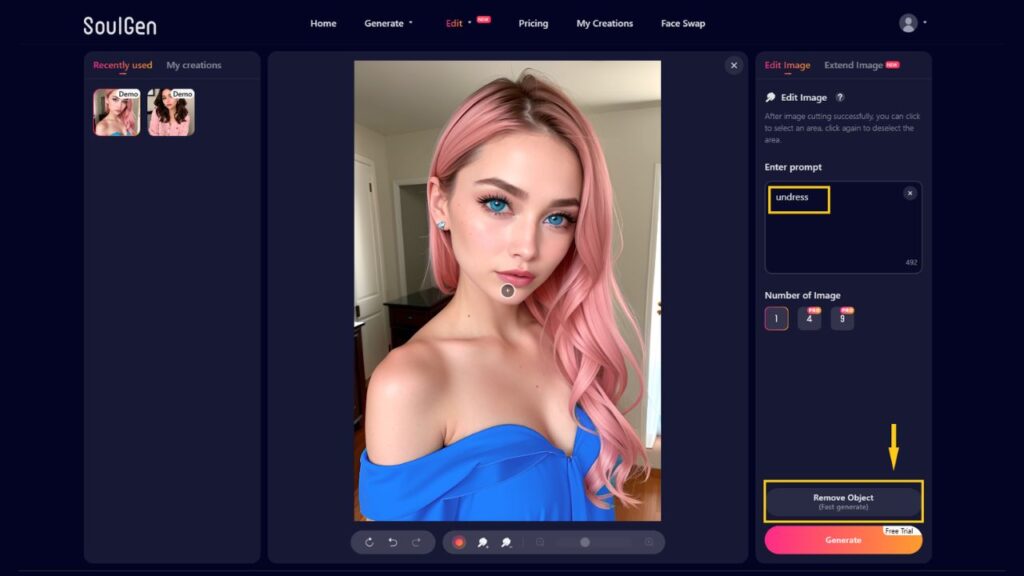Is it truly possible to alter reality with a few clicks, and what are the implications of such power? The rise of AI-powered photo manipulation tools presents both exciting possibilities and profound ethical dilemmas, forcing us to confront the boundaries of creativity and responsibility.
The digital landscape is rapidly evolving, with artificial intelligence (AI) becoming increasingly integrated into our daily lives. One area where AI is making a significant impact is in image manipulation. Tools that once required professional expertise and complex software are now accessible to anyone with an internet connection and a smartphone. These tools promise to revolutionize everything from fashion design to personal expression, but they also raise serious questions about privacy, consent, and the potential for misuse.
Consider the scenario: A fashion designer, instead of painstakingly creating physical garments, can now use AI to instantly visualize how a new design would look on a model. Or, an individual can experiment with different styles and looks by virtually "trying on" clothes without ever having to change. The possibilities seem limitless. However, lurking beneath the surface of convenience and innovation are complex ethical considerations.
One prominent application of this technology involves the ability to alter the appearance of individuals in photographs. This can range from simple adjustments like changing the color of clothing to more complex manipulations that remove clothing altogether. Several platforms and applications are now offering these services, promising ease of use and impressive results.
It is important to emphasize that tools like Undressher AI, nudify ai app, clothoff, "Unclothy," and other AI-powered image manipulators are not just technological novelties; they are instruments that demand careful consideration of their potential impact on individuals and society.
The promise of these tools is often presented in terms of creative freedom, convenience, and entertainment. For instance, users can "remove clothes from photos with our online ai nudifier for free," or "experience the fun and excitement of ai to nudify photos like never before." The marketing often focuses on the ease with which images can be altered, with claims that the process is "simple, with minimal steps required to generate altered photos." Some applications even boast about their ability to provide "precise and realistic results."
However, this focus on ease and excitement often overshadows the serious ethical concerns. The ability to generate realistic, altered images of individuals without their consent opens the door to potential misuse, including:
- Non-consensual Image Creation: The ability to create images that depict a person in a state of undress without their knowledge or permission is a grave violation of privacy and bodily autonomy.
- Deepfake and Misinformation: Altered images can be used to spread false information, damage reputations, and manipulate public opinion. The potential for deepfakes to be used in political campaigns or to target individuals is a significant threat.
- Cyberbullying and Harassment: These tools can be used to create and disseminate images that are intended to humiliate, harass, or threaten individuals, particularly women and girls.
- Exploitation and Abuse: The technology can be exploited for malicious purposes, including creating child sexual abuse material (CSAM) and other forms of exploitation.
The following table provides a summary of some of the AI tools and platforms mentioned in the source material, along with their key features and potential risks:
| Tool/Platform | Key Features (As Advertised) | Potential Risks |
|---|---|---|
| Undressher AI | Free AI service to undress people in photos; claims to offer precise and realistic results. | Potential misuse and invasion of privacy; creation of non-consensual images. |
| Online AI Nudifiers (unspecified) | Remove clothes from photos; experience the fun and excitement of ai to nudify photos. | Risk of creating non-consensual images; potential for misuse and distribution of altered images. |
| Clothoff | Ultimate AI tool for photo undressing; upload photos, adjust settings, get precise results. | Potential misuse and privacy violations; can be used to generate inappropriate content. |
| Unclothy | AI tool designed to undress photos; leverages advanced AI models to automatically detect and remove clothing. | Serious ethical concerns related to non-consensual image creation and deepfakes. |
| Ptool's AI Clothes Remover | Erase clothes and swap to new outfit styles. | Misuse and privacy violations. |
| Nudify AI App | Transform photos; simple process to generate altered photos. | High risk of creating non-consensual and potentially harmful content. |
| Slazzer 3.0 | Free undress AI tool that is available online | Potential misuse and privacy violations |
| Undress.app | Innovative AI undresser tools; seamless undressing AI. | Potential misuse and privacy violations |
In the realm of fashion design, these AI tools are marketed as a way to revolutionize the design process. "Revolutionize your fashion design process with our ai clothes remover, enabling designers to effortlessly prototype and visualize new clothing concepts on models without the need for physical garments." This application streamlines the creation of new designs, making it easier for designers to experiment and visualize their ideas. However, the implications of this technology extend far beyond the fashion industry.
The ethical concerns surrounding these tools are multifaceted and require a multi-pronged approach to address. The creators of these technologies bear a significant responsibility to ensure that their products are used ethically and responsibly. This includes:
- Implementing Robust Safeguards: Developing and implementing measures to prevent the misuse of these tools. This might include watermarking altered images, detecting and flagging potentially harmful content, and preventing the creation of images that violate privacy or promote harmful stereotypes.
- User Education and Awareness: Educating users about the ethical implications of these tools and providing clear guidelines for responsible use.
- Transparency and Accountability: Being transparent about the capabilities and limitations of the technology and being accountable for any misuse of the tools.
Governments and regulatory bodies must also play a crucial role in establishing clear legal frameworks and guidelines for the use of AI-powered image manipulation tools. This may include:
- Data Privacy Regulations: Strengthening data privacy laws to protect individuals' images and personal information.
- Consent Requirements: Establishing clear rules regarding consent for the use of an individual's likeness in altered images.
- Criminalizing the Creation and Distribution of Non-Consensual Images: Enacting laws that criminalize the creation and distribution of images that violate an individual's privacy or autonomy.
- Content Moderation: Requiring platforms and social media sites to actively moderate content and remove images that violate these guidelines.
As the technology continues to evolve, it is imperative that we have an open and honest dialogue about the ethical and societal implications of AI-powered image manipulation. This dialogue should involve technologists, ethicists, policymakers, and the public at large. Only through a collaborative effort can we ensure that these tools are used responsibly and ethically, and that the benefits of technological advancement are not achieved at the expense of individual rights and societal well-being.
The ability to alter images with such ease has profound implications for the concepts of trust and authenticity. In a world where it is increasingly difficult to distinguish between what is real and what is fabricated, we must all become more discerning consumers of information and more vigilant in protecting our privacy and the privacy of others. The future of image manipulation technology will be shaped by the choices we make today.
Furthermore, it is crucial to recognize that the issue transcends mere technological capabilities. The potential for misuse stems from underlying societal issues such as sexism, objectification, and the prevalence of harmful stereotypes. By understanding the potential risks associated with image alteration and working together, we can harness the power of AI while protecting the values that we hold dear.
The evolution of AI is constantly reshaping our world, and as the technology advances, it is imperative that we reflect on the ethical and societal effects it has on humanity. Responsible utilization and open discussion are vital in charting the course of this future, ensuring technological advancement benefits everyone.

